This family comprises all but a few species of the arboreal tree frogs of Africa, Madagascar, and the Seychelles Islands. In terms of species numbers, it is the largest family in East Africa, with over 70 known members; there will be many more if the Common Reed Frog (Hyperolius viridiflavis) ‘complex’ is split.
Tree Frogs range in size from the tiny 17mm Dwarf Reed Frog Hyperolius minutissimus, of southern Tanzania, to the 110mm Principe Giant Tree Frog Leptopelis palmatus, endemic to a single island in the Gulf of Guinea.
Most species are relatively slender, have smooth skin, and greatly expanded finger and toe tips for climbing. All members of the family have a small bony or cartilaginous structure (the intercalary element) between the last and penultimate bone of the fingers and toes: this apparently allows the expanded finger and toe tips to rotate more freely in climbing.
In most, the hind limbs are much longer than the forelimbs with the exception of a few of the terrestrial species. Adult males of all species except in the genus Leptopelis (tree frogs) have a conspicuous thick chin, or gular, glands covering the vocal sac.
All known species are dependent upon water for development, which includes a free-swimming tadpole stage. Most are active at night, and different groups (genera) may be distinguished by their advertisement calls. Shape of the pupil is important in identification to genus: genera of this family have pupils that are either horizontally oval, rhomboidal (diamond-shaped), or vertical.
Genus Leptopelis: Tree Frogs Species
Recent work suggests that members of this genus represent a separate family, the Leptopelidae. They are medium-sized to large, nocturnal, arboreal frogs, always with vertical cat-like pupils, long hind legs, and enlarged finger and toe tips.
The tympanum is usually distinct and visible. Unlike other members of the family, the male gular glands are absent. Males of some species have flattened glands visible ventrally where the arms join the trunk (pectoral glands). In most species, females are noticeably larger than males.
Where known, reproduction in these tree frogs includes a breeding pair burying large eggs in the soil near water or in a depression that will become rain-filled. The eggs seem to develop rather slowly, and the thin, slender larvae then make their way overland to nearby water.
Advertising calls are rather unmusical clacks, buzzes, and, in some, a cat-like whine; some species have bimodal calls, the two portions of which are radically different from each other. Members of this genus are mostly forest forms and absent from the arid, semi-desert areas of East Africa. There are a few species that are terrestrial or fossorial.
Silvery Tree Frog – Leptopelis argenteus (including Leptopelis concolor)
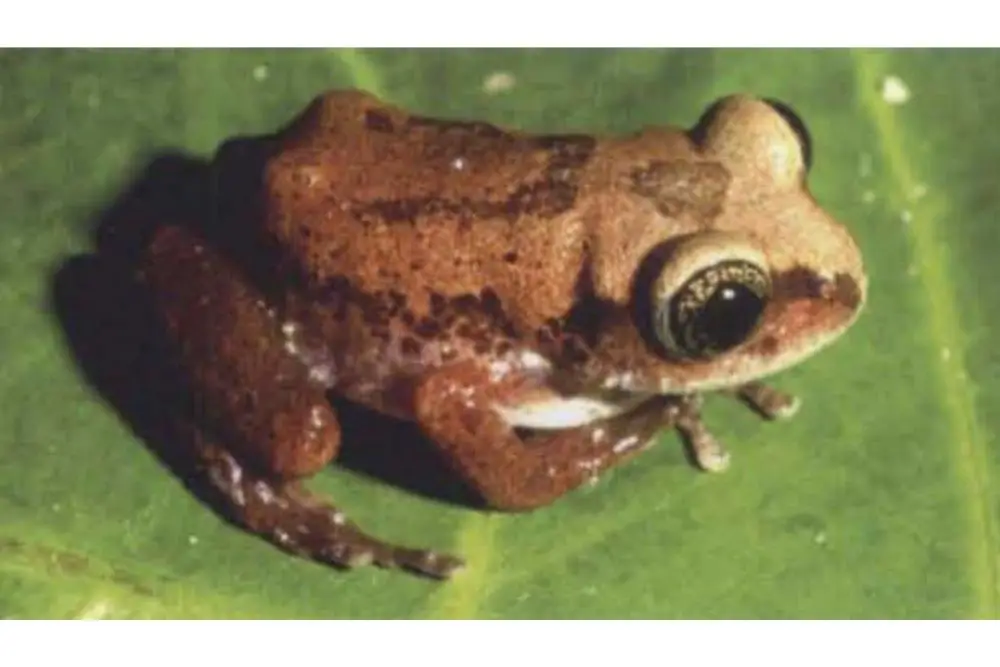
Identification : Up to 34mm. Smallish, stout brown tree frog with nonprotruding eyes; male pectoral glands absent; webbing is reduced; male and female coloration similar, usually light brown with a darker bar or reverse pyramid-shaped marking between the eyes; never any green.
Northern individuals have a vague V-shaped marking on the back, southerly individuals frequently lack the interorbital bar but have two darker brown paravertebral stripes.
API STRESS COAT Aquarium Water Conditioner 16-Ounce Bottle
29% OffAPI STRESS ZYME Freshwater and Saltwater Aquarium Cleaning Solution 16-Ounce Bottle
API ACCU-CLEAR Freshwater Aquarium Water Clarifier 4-Ounce Bottle
12% OffHabitat and Distribution: Bushes or low trees in clearings, even plantations and disturbed areas from river deltas in south coastal Somalia south through coastal Kenya and eastern Tanzania into Mozambique.
Tree frog call: Calls from bushes in openings outside forest proper. Male call bimodal: atonal claack!, followed immediately by 2 or 3 yiiinnggg sounds.
Taxonomic Note: Some consider the southern striped form to be a separate species, L. concolor; but distributions confluent and advertisement calls identical.
Bocage’s Burrowing Tree Frog – Leptopelis bocagii
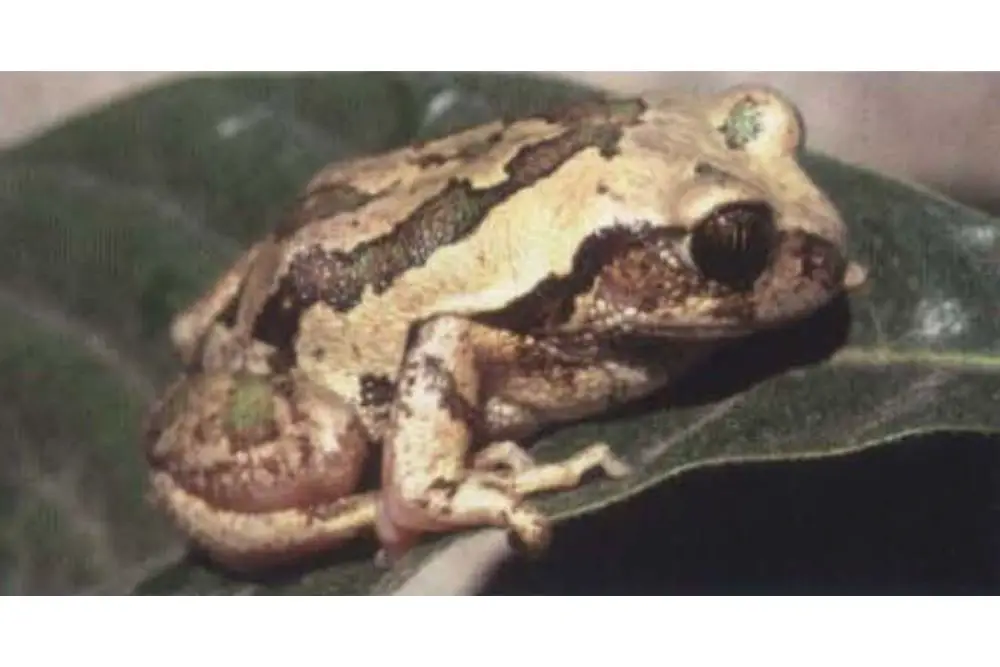
Identification: Males to 50mm, females to 58mm. Lives on the ground. Large, stout frog, non-protruding eyes, lacks expanded disks on fingers and toe. Webbing on feet very reduced. Well-developed spade-like tubercle on inner part of heel (metatarsal tubercle) which may aid digging.
Pectoral glands present in males. Usually medium brown with darker brown, M-shaped blotch on back.
Habitat and Distribution: Inland grassland and savannah of moderate elevation from western and central highlands of Kenya, south through western Tanzania, may occur as far south as northern Namibia and Zimbabwe (type locality Angola). Several cryptic species may be included in this distribution.
Tree frog call: Call long, slow waaah emitted from ground. Large numbers may occur but usually only encountered during a major rainfall. Eggs apparently deposited in deep holes in ground, tadpoles unknown. Can form cocoon of epidermis, within which it avoids evaporative water loss during dry seasons.
Ornate Tree Frog – Leptopelis flavomaculatus
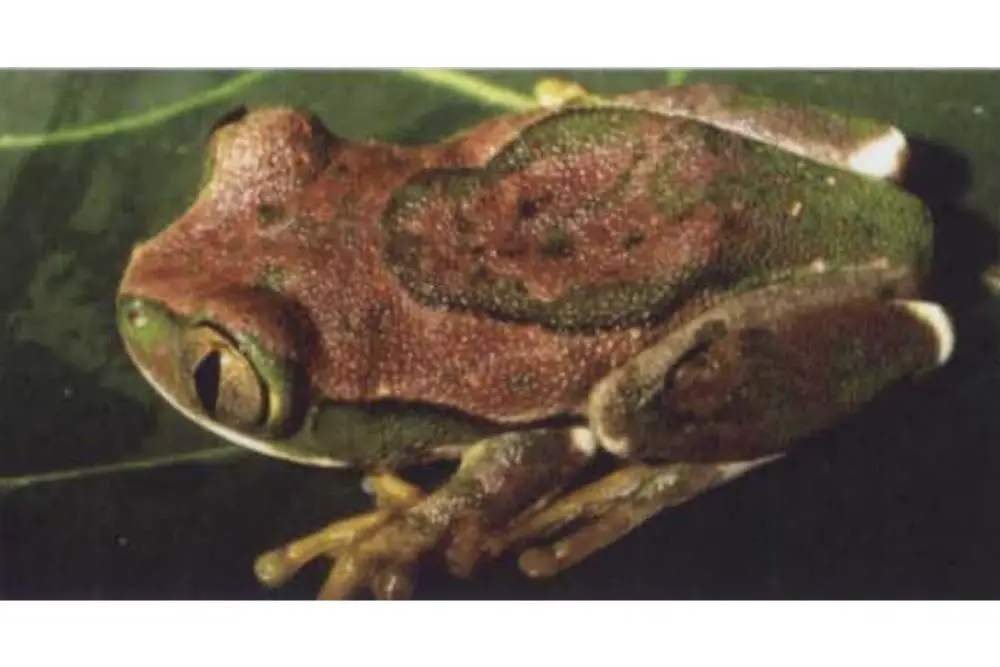
Identification: Males to 50mm, females to 70mm. Large with bulging eyes and short snout, moderately developed webbing between toes; males have pectoral glands; male color pattern variable but always some green (which Glade Tree Frog lacks) males’ heels and knees white-tipped; males uniform green or mix of green and brown, may have large, broad-armed dorsal inverted U-shape pattern. Females usually have high contrast, similar, light cream U-shaped pattern on rich dark brown background.
Habitat and Distribution: Dry open forest. Coastal Kenya south through most of southeastern Tanzania in various dry deciduous forests (but excluding moist evergreen forests of Eastern Arc).
Tree frog call: Reproduction presumably similar to other Leptopelis where known. In Arabuko Sokoke Forest, Kenya, where it is found close to the Glade treefrog. The call is a cat-like weaao or waaao.
Albertine Rift Tree Frog – Leptopelis kivuensis
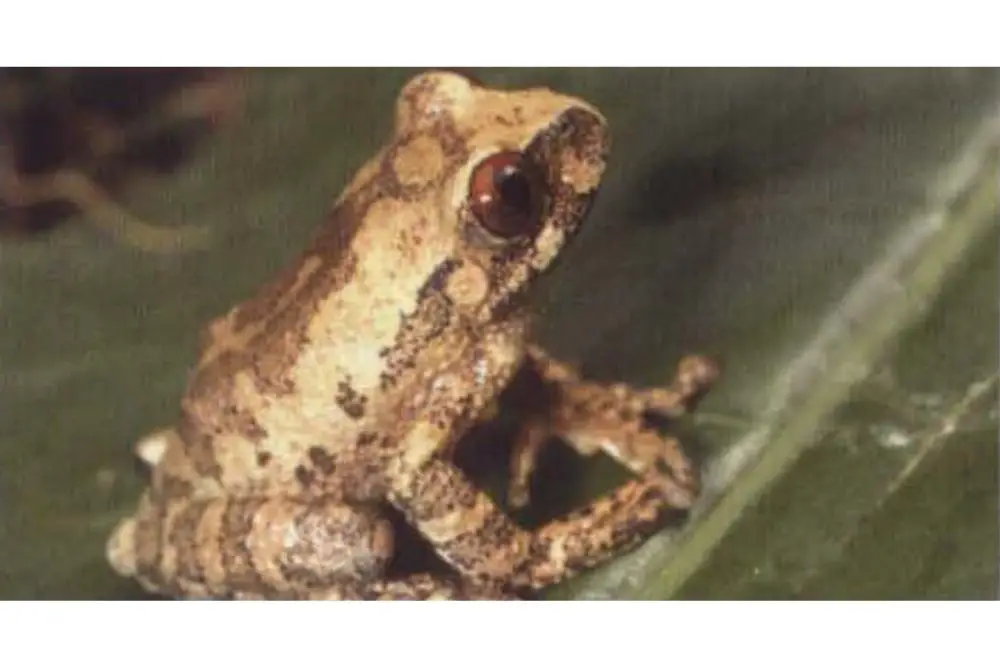
Identification: Males to 36mm, females larger to 50mm. A high
altitude forest-dependent tree frog. Both sexes have protruding eyes, conspicuous all-red irises, and striking white spot on upper lip
below eye. Tympanum (ear drum) about half the diameter of the eye; toe webbing rather reduced.
Male pectoral glands large and conspicuous; adult males have loose darkish skin in the chin area. Light to moderate brown, often with X-shaped blotch on back; frequently upper arms of ‘X’ are joined by an interorbital bar. Newly metamorphosed young bright green without markings.
Habitat and Distribution: Glades and swamps, riverside vegetation and
forest clearings near water in montane forest up to 2800m (but three
juveniles reported at around 4000m in the Virunga volcanoes).
Tree frog call: Has bizarre defensive behavior; when disturbed flattens its back, raises arms and legs off ground and partially opens mouth. Can hold this position for several seconds. Males call with a loud, non-musical clack from bushes, sedges, or other vegetation between 1.5 and 2m above ground.
Vermiculated Tree Frog – Leptopelis vermiculatus
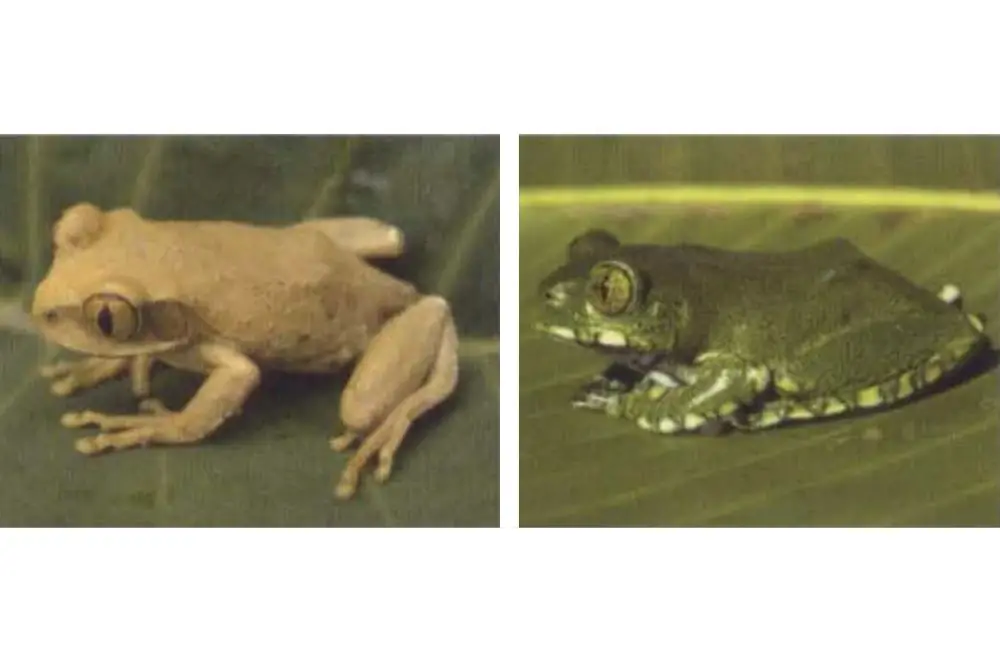
Identification: Perhaps the largest Eastern Arc tree frog; females to 85mm, with rather a stout body. Female and juvenile coloration usually a vivid green with fine black vermiculations, sides are blotched black and white. Most males are brown with various patterns.
Habitat and Distribution: Known from the forests of East and
West Usambaras, Mt Rungwe, and the Udzungwa Mountains.
Natural History: Sits quietly on branches above water. Able
to change color over time.
Parker’s Tree Frog – Leptopelis parkeri
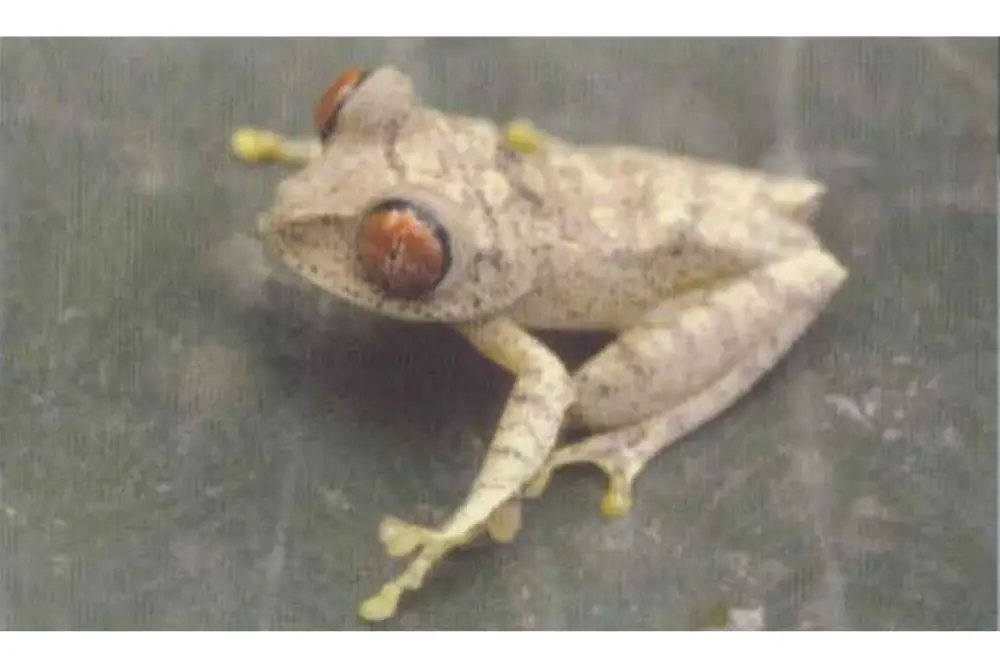
Identification: A rather slender tree frog with females up to 56mm. May be distinguished from other Eastern Arc tree frogs by its bright red iris. Colour pattern extremely variable and may be composed dorsally of wavy bands of various colors to patterns similar to tiger stripes. This is one of the most beautiful of the forest tree frogs.
Habitat and Distribution: It is known so far from the South Pare Mountains, the East, and West Usambaras, the Ulugurus and the Udzungwas.
Tree frog call: The voice is a quiet buzzing. Fairly common in areas of dense forest.
Barbour’s Tree Frog – Leptopelis barbouri
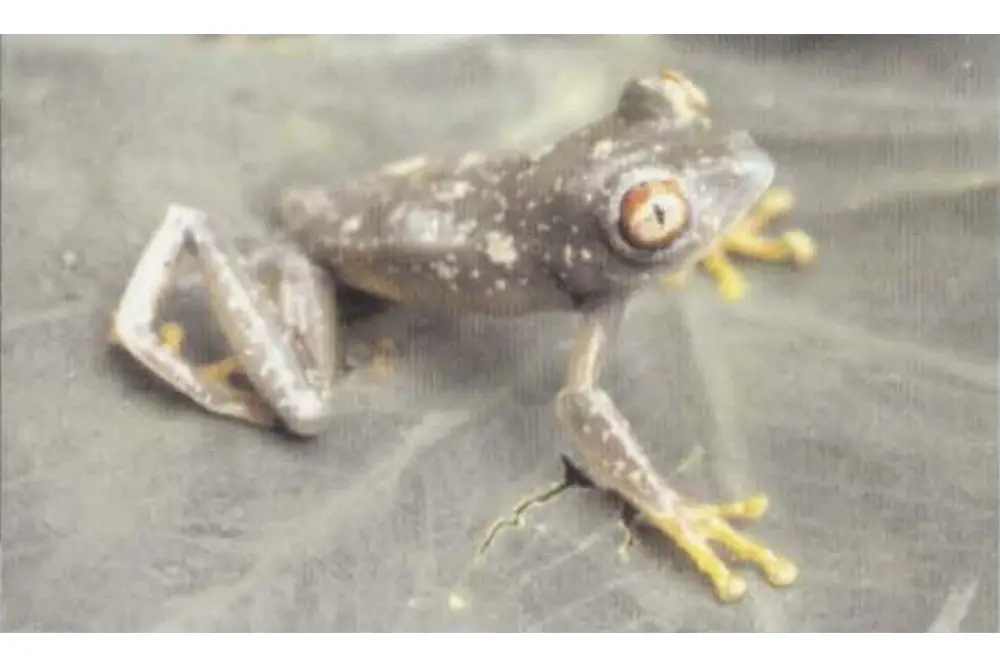
Identification: A rather small, slender, Eastern Arc tree frog (females to 43mm), identifiable by the male’s bright, cobalt-blue vocal sacs. Dorsal coloration may be light to middle green with a fine lacy pattern in white; some individuals may be nearly silver in coloration. Iris of eye may be reddish on the periphery but not entirely red as in Parker’s Tree Frog.
Habitat and Distribution: So far known from the East and West Usambara Mountains and the Udzungwa Mountains, but expected in the Ulugurus.
Tree frog call: Curiously, this species has bile pigments in the circulatory system resulting in green muscles, bone, and blood. The males call from branches near streams, at a height of 2-6m. The voice is a brief buzzing.

Hi, my name is Sean, and I’m the primary writer on the site. I’m blogging mostly about freshwater and saltwater aquariums, fish, invertebrates, and plants. I’m experienced in the fishkeeping hobby for many years. Over the years I have kept many tanks, and have recently begun getting more serious in wanting to become a professional aquarist. All my knowledge comes from experience and reading forums and a lot of informative sites. In pursuit of becoming a professional, I also want to inspire as many people as I can to pick up this hobby and keep the public interest growing.
Read more about Sean.
Please join also my Facebook group.

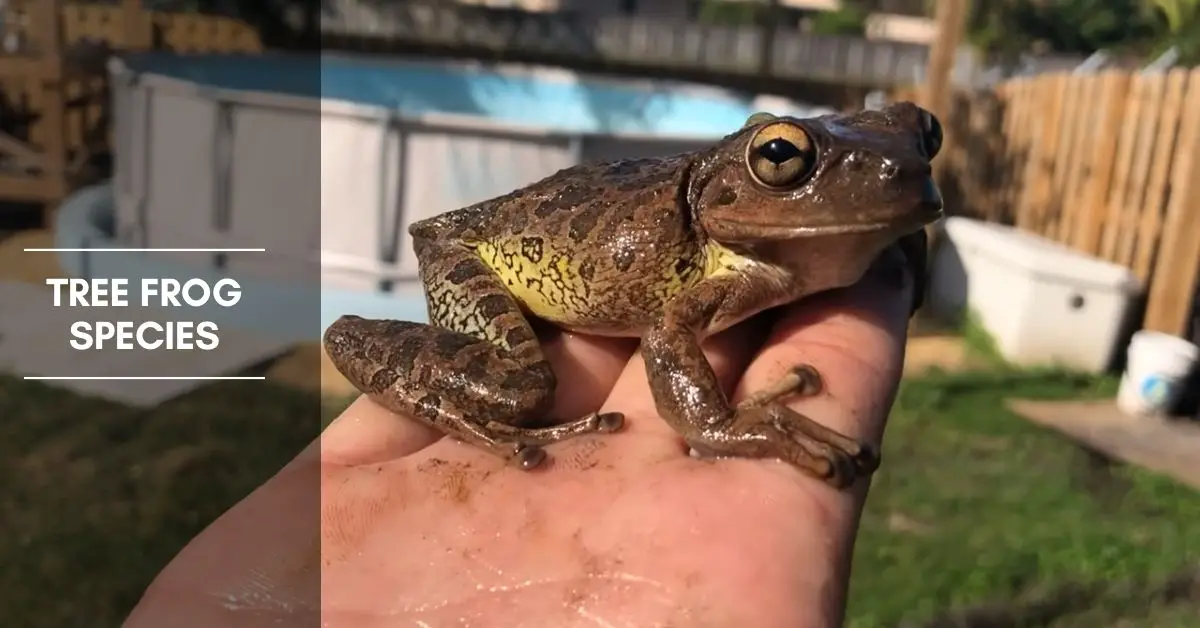



















1 thought on “Mixing Tree Frogs – Can Different Species of Tree Frogs Live Together?”
Comments are closed.